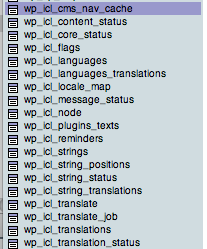Forum Replies Created
-
AuteurArticles
-
Read carefully this article – http://multilingual.wpmu.xilione.com/346/episode-4-multilingual-nav-menus/ – and the last comment :
as you can see in the figure, the args used as in wp_list_pages template permits to nav menu to choose in the list those pages that are in the target language… In the illustrated example with only two pages (2,3) if 2 is in french, this page with id 2 will only displayed…
test, try and enjoy !
M.
30 June 2011 at 18:18 in reply to: xili-language plugin data model and architecture : FAQ [updated] #2109After been used by webmasters for cms multilingual websites, more and more, xili-language trilogy is used by newbies. This article summarizes some questions about how the data model and architecture were choosen at begining and year after year confirmed. In these lines we detail some features and comparisons made in WordPress Codex.
A recent joined pdf (see at end) summarizes elements about data-model.
Some basic features of WP :
The core of WP is posts table with main columns like « title« , « content« , « author« , « date« ,…
The classification of posts is based on categories and post tags.
Category is like a shelf in a bookcase. And post tag is like color stamp or label on a book.
The insertion of taxinomy library since WP 2.3 offers a powerful tool to create other taxinomies.xili-language based on the solid architecture of WP :
xili-language since WP 2.3 (24 September 2007) introduces a new taxonomy named « language » with query var named « lang ».
xili-language DON’T modify the content of each post. No inconsistency introduced in data model.
one example : what happen in the free plugin named qtranslate ?
after activation of this plugin, all content items of posts are modified – new tags etc… – because inside the field, the content is the sum of the texts in each language 2, 3 and more … as you can see in this snapshot of phpMyAdmin.
[caption id="attachment_2113" align="aligncenter" width="300" caption="DB modified by qTranslate"] [/caption]
[/caption]
or after desactivating qtranslate plugin, all contents become unreadable and unexportable in post dashboard UI.
[caption id="attachment_2114" align="aligncenter" width="300" caption="posts list"] [/caption]
[/caption]xili-language don’t add any table. (like more then 13 in WPML plugin – compared to the original 11 tables of WordPress) – to recover or transfer posts in one language, it become very complexe…
[caption id="attachment_2118" align="aligncenter" width="207" caption="wpml tables"] [/caption]
[/caption]
To organize posts and pages (and custom posts) in xili-language :
Only custom fields are added to link one post in a language and these translations in other languages. The taxonomy remains usable even if xili-language is desactivated by using custom taxonomy introduced recently.
With small functions, it is easy to export posts attached to a specific language.Some questions :
Why xili-language don’t provide flags for language ?
xili-language works on the contents and not appearance. What happens in a country with one flag and three current languages ?
On this site, an example of child theme based on twentyten is provided.Why xili-language don’t add a specific UI to have together a post and his translation ?
Because current well designed browsers has tabs and because when you translate, it is recommanded to have two screens and two windows !Why xili-language don’t include xili-tidy-tags to organize tags according language ?
Because xili-tidy-tags can be used in mono language current websites to organize semantically large quantity of tags.Why download quantities in WP plugin repository with others are so different ?
The best way to compare is not the total quantity but the peak during updating. And a young history like WP roadmap since version 1.
Why xili-language don’t translate ?
In dev.xiligroup team speaks only less than two languages 😉 but we provide tools to organize and create CMS multilingual and semantic sites…
The original article in WordPress Codex is not very explicit on the subject – one language, one WordPress instantiation ?
WordPress is basically localizable but not multilingual. Current multilingual plugin works inside one instantiation of WP and all posts are in the same website. To adapt the behavior, the process to switch between languages can be very complex with a lot of hooks and API to translate the terms of theme and widget… With avaibilility of WP network since version 3.0, a new elegant solution is possible… it is why xili-language premium is born : see this post which presents the main features.How to choose multilingual plugins ?
Like a house or a car… according the features you want, the reversibility, the sustainability… and with understanding how it is developed and how the data model is conserved or modified…Any other questions ? Use form below or forum !
Michel of dev.xiligroup
A skilled colleague from same country of me edit this plugin – http://wordpress.org/extend/plugins/simple-tags/ – it is a good complement to answer your ergonomic question…
Just for you info : in WP, via the post-tag menu, you can create a pre-list of tags and in post edit, author has only to check inside this pre-list…
Thanks for your topic.
To resume xili-tidy-tags plugin groups tags which are associated with post(s). The widget shows (as current wp_tag_cloud) cloud of tags and when clicking on a tag, the list of attached posts are listed. A preset tag, but without post attached is not displayed.
Grouping … on dev.xiligroup.com a cloud of tags is displayed through the group of trademarks (grouping only tags describing a trademark (WordPress, Apple, Cisco, xiligroup…). On a multilingual website, such a group is interesting because a tag like wordpress is not attached to a language but to a (famous) trademark… and when clicking on it the result can display every posts regardless languages.
It is also possible to attach tags to a group similar to a category, so when displaying a category (ie color), the cloud will display only tags belonging to the group color (red, yellow,…)… if well set, when clicking on a tag, a list of posts with that tag color will be displayed. The origin of that features was on some musical website, webmasters have HUGE tags clouds (large in semantic areas) and want only display musicians tags, when selecting posts from category musicians…
On a multilingual website, the tags are grouped according languages and currently a transverse group « trademark »
Hope that help you to understand powerfulness of xili-tidy-tags !
Enjoy
xili-language trilogy as delivered in wordpress plugins repository is, as other plugins, delivered under GPL2 – http://www.gnu.org/licenses/license-list.html#GPLCompatibleLicenses – You can use – as is – free – for commercial or non commercial use. You can also include in your costs for your customer a donation
 or time to publish a review to share your knowledge with these plugins.
or time to publish a review to share your knowledge with these plugins.If you work alone and spend time to understand the code source, you will autonomous.
But, traditionally, some professional developers as you, tell me buy complementary services and expertises to help them and reduce time to understand the deep features (and hooks) of the trilogy or some advices to build good multilingual cms or to recover posts from a website motorized with another multilingual plugin. For more details and references, use contact form : https://dev.xiligroup.com/?page_id=10
29 June 2011 at 7:25 in reply to: to be or not newbie – questions to start with xili-language ! #2581here some questions received through support email :
I very value your product, it increase functions of my website. Looks like my theme is not international compatible. What to do in this case?
If the theme is not localizable, two solutions 1- find the author and ask him to add gettext compatible functions as set in localizable theme like default twentyten or twentyeleven. (or find a friend easy in php…)
My second question is: when I activated plugin there is no language switcher displays in my main page on web-site. How to display that switch?
The best way to understand how xili-language works, is to read carefully readme in plugin repository http://wordpress.org/extend/plugins/xili-language/ and to visit demo site http://multilingual.wpmu.xilione.com/ .
Main page (home page) – there is an option in settings to subselect the posts according the current lang of browser.
to temporary conclude:
Originally 3 years ago, xili-language is built for webmasters with minimum knowledges in WP and Php… For newbies, we hope to provide new features and new docs before end of 2011… if time available…
QUESTION
I installed xili plugins, and started to tune it with my theme ‘mymag’ , I would like to know whether mymag is compatible with xili and am i going in the right direction in the integration? as i cant find .POT file in my languages directory.
what is the actual method of translation of the words in the xili dictionary, shall i manually translate the phrases and words or it is done by the plugin itself?
SOLUTION
the target files must be inside theme folder and/or a sub-folder declared in functions.php with load_themedomain function. If one file .po is present, copy it and change his name with suffix of language… and with text editor change the msgstr lines with good translation for the target language..
Very good remark

The next release (2.2.0) will include pre-checked radio button according current language… as soon visible in tests here :
http://multilingual.wpmu.xilione.com/
Be patient,
Please take a little time…
basically twentyten and his function
twentyten_posted_on() {use get_the_time without param… and it’s work as in child..It means that wp+xili-language translate the date format set in general settings. If you want your own format, you must used __() function to set your target date format… (and his translation in other language in .po + .mo)…
-
AuteurArticles


